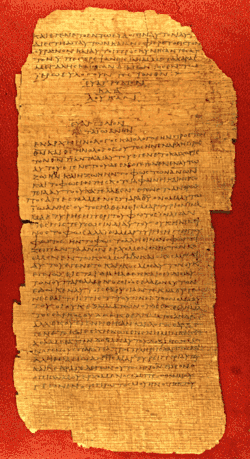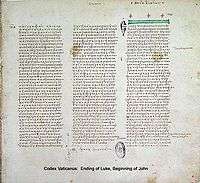Luke 24
| Luke 24 | |
|---|---|
|
John 1 → | |
 Luke 24:51-53, continued with John 1:1-16, on Papyrus 75, written about AD 175-225. | |
| Book | Gospel of Luke |
| Bible part | New Testament |
| Order in the Bible part | 3 |
| Category | Gospel |
| Gospel of Luke |
|---|
Luke 24 is the twenty-fourth and final chapter of the Gospel of Luke in the New Testament of the Christian Bible. It records the discovery of the resurrection of Jesus Christ, his appearances to his disciples and his ascension into heaven.[1] The book containing this chapter is anonymous, but early Christian tradition uniformly affirmed that Luke composed this Gospel as well as the Acts of the Apostles.[2]


Text
- The original text is written in Koine Greek.
- Some most ancient manuscripts containing this chapter are:
- Papyrus 75 (written about AD 175-225)
- Codex Vaticanus (325-350)
- Codex Sinaiticus (330-360)
- Codex Bezae (c. 400)
- Codex Washingtonianus (c. 400)
- Codex Alexandrinus (c. 400-440)
- Codex Ephraemi Rescriptus (c. 450; extant: verses 1-6, 46-53)
- This chapter is divided into 53 verses.
Structure
The New King James Version organizes this chapter as follows (with cross references to parallel passages in the other gospels):
- Luke 24:1-12 = He Is Risen (Matthew 28:1-10; Mark 16:1-8; John 20:1-10)
- Luke 24:13-27 = The Road to Emmaus
- Luke 24:28-35 = The Disciples’ Eyes Opened
- Luke 24:36-43 = Jesus Appears to His Disciples (John 20:19-23)
- Luke 24:44-49 = The Scriptures Opened
- Luke 24:50-53 = The Ascension
Verse 1
- Now on the first day of the week, very early in the morning, they, and certain other women with them, came to the tomb bringing the spices which they had prepared.[3]
"They" refers to "the women who had come with Him from Galilee" (Luke 23:55), who are "Mary Magdalene, Joanna, Mary the mother of James, and the other women with them" (Luke 24:10). The Cambridge Bible for Schools and Colleges suggests that the words "certain other women" are a spurious late insertion, not being part of the text in the Codex Sinaiticus, Codex Vaticanus, Codex Ephraemi Rescriptus or Codex Regius manuscripts.[4]
Verse 10
- It was Mary Magdalene, Joanna, Mary the mother of James, and the other women with them, who told these things to the apostles.[5]
Only Luke's gospel mentions Joanna.
Verse 12
- He saw the linen clothes lying by themselves.[6]
Ameican biblical scholar Kim Dreisbach states that Greek: οθονια (othonia) is "a word of uncertain meaning ... probably best translated as a generic plural for grave clothes". The same word is used in John 19:40.[7]
Verse 53
- [They] were continually in the temple praising and blessing God. [Amen]. [8]
Luke's gospel ends where it began:[9] in the temple.[10]
The King James Version ends with the word "Amen", following the Textus Receptus, but modern critical editions of the New Testament exclude this word, as do many modern English translations.[11] In a manuscript copy of Beza's, the word's are added:
- The Gospel according to Saint Luke was published fifteen years after the ascension of Christ,[12]
a tradition also known to the eleventh-century Byzantine bishop Theophylact of Ohrid.[13]
See also
- Ascension of Jesus
- Emmaus
- Holy Week
- Jerusalem
- Ministry of Jesus
- Resurrection of Jesus
- Other related Bible parts: Matthew 28, Mark 16, Luke 23, John 20, Acts 1, Acts 2, 1 Corinthians 15
References
- ↑ Halley, Henry H. Halley's Bible Handbook: an Abbreviated Bible Commentary. 23rd edition. Zondervan Publishing House. 1962.
- ↑ Holman Illustrated Bible Handbook. Holman Bible Publishers, Nashville, Tennessee. 2012.
- ↑ Luke 24:1
- ↑ Cambridge Bible for Schools and Colleges on Luke 24, accessed 27 July 2018
- ↑ Luke 24:10
- ↑ Luke 24:12
- ↑ The Definitive Shroud of Turin FAQ, accessed 27 July 2018
- ↑ Luke 24:53
- ↑ Luke 1:9
- ↑ Jerusalem Bible (1966), footnote at Luke 24:53
- ↑ BibleGateway.com, Translations of Luke 24:53
- ↑ Gill, J., Gill's Exposition of the Entire Bible on Luke 24, accessed 28 July 2018
- ↑ Theophylact of Ohrid, Preface to the Gospel of Matthew, accessed 28 July 2018
External links
| Preceded by Luke 23 |
Chapters of the Bible Gospel of Luke |
Succeeded by John 1 |